Centrifugation In Pharmaceutical Engineering Introduction
Centrifugation is a common technique in the pharmaceutical industry used for the separation of constituents present in liquid with the help of centrifugal force.
Centrifugation is a technique that involves the application of centrifugal force to separate particles from a solution according to their size, shape, density, viscosity of the medium, and rotor speed. This process is used to separate two miscible liquids or solids from liquids.
The components that are dense in the mixture migrate away from the axis of the centrifuge, while less-dense components of the mixture migrate towards the axis. This process causes the formation of ‘pellet’ of the dense component at the bottom. The remaining solution (supernatant) may be discarded with a pipette.
There is a correlation between the size and density of a particle and the rate at the particle separates from a heterogeneous mixture when the only force applied is that of gravity. The larger the size and the larger the density of the particles, the faster they separate from the mixture.
By applying a larger effective gravitational force to the mixture, like a centrifuge, the separation of the particles is accelerated. This is ideal in industrial and lab settings because particles that would naturally separate over a long period can be separated in much less time (for evaluation purposes).
The rate of centrifugation is specified by the angular velocity usually expressed as revolutions per minute (RPM), or acceleration expressed as g. The most common application of centrifugation is the separation of solids from highly concentrated suspensions, which is used in the treatment of sewage sludges for dewatering where less consistent sediment is produced.
Centrifugation Objectives
- To separate the immiscible liquids.
- To purify the component by removing impurities in the supernatant liquid.
- To separate crystalline drugs from mother liquor.
- To test the emulsions and suspensions for creaming and sedimentation at accelerated speed.
Centrifugation Applications
- Production of bulk drugs: After crystallization, the drugs are separated from the mother liquor by centrifugation. For example, traces of mother liquor is separated from aspirin crystals by centrifugation method.
- Production of biological products: The proteinaceous or other macromolecules remain in the water as colloidal dispersion during their manufacturing it is difficult to separate them by common methods of separation
- Evaluation of suspensions and emulsions: One of the problems of suspensions is sedimentation and one of the problems of emulsions is creaming. These do not occur immediately after formulation. These problems develop over time. So quick evaluation of these problems can be done by enhancing the speed of creaming and sedimentation by centrifuge machine.
- Determination of molecular weight of colloids: Polymers, proteins, and such macromolecules often form colloidal dispersions. The molecular weights of that molecule can be determined by ultracentrifugation. The larger molecules will be arranged at the periphery and the lighter molecules near the center.
Other applications:
- Separating chalk powder from water.
- Removing fat from milk to produce skimmed milk.
- Separating particles from an air-flow using cyclonic separation.
- The clarification and stabilization of wine.
- Separation of urine components and blood components in forensic and research laboratories.
- Aids in the separation of proteins using purification techniques such as salting out, For example: ammonium sulfate precipitation.
Centrifugation Principle
The centrifuge involves the principle of sedimentation, where the acceleration at centrifugal force causes denser substances to separate along the radial direction at the bottom of the tube.
By the same concept lighter objects will tend to move to the top of the tube; in the rotating picture, move to the center.
- In a solution, particles whose density is higher than that of the solvent sink (sediment), and particles that are lighter than it float to the top. The greater the difference in density, the faster they move.
- If there is no difference in density (isopycnic conditions), the particles stay steady.
- To take advantage of even tiny differences in density to separate various particles in a solution, gravity can be replaced with the much more powerful “centrifugal force” provided by a centrifuge.
- Particles having a size above 5 pm sediment at the bottom due to gravitation force.
- Such a suspension can be separated by simple filtration techniques.
- If the size of particles is less than 5 pm they undergo Brownian motion. In such suspension, a stronger centrifugal force is applied to separate the particles.
- It is convenient to measure the centrifugal force in terms of ratio to the gravitational force, that is the number of times the centrifugal force is greater than the gravitational force.
- Let us consider a body of mass m rotating in a circular path of radius rat a velocity of ‘V’.
The force acting on the body in a radial direction is given by:
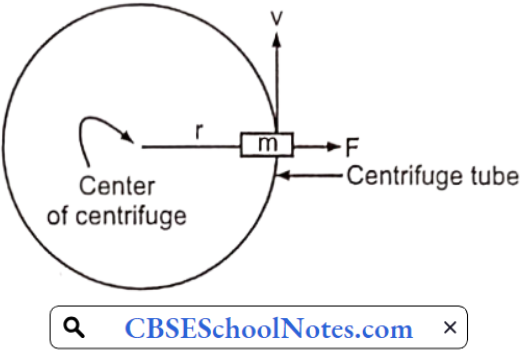
F = mv²/R
Where,
F = Centrifugal force
m = Mass of body
v = Velocity of the body
R = Radius of the circle of rotation
The gravitational force acting upon the same body G = mg.
Where,
G = Gravitational force
g = Acceleration due to gravity
The centrifugal effect is the ratio of the centrifugal force and gravitational forces so that
Centrifugal force = Force acting radially/ Gravitational force
C = F/G
= mv²/mgr
= v² / gr
Since, v = 2πrn
Where,
n = Speed of rotation (r.p.m)
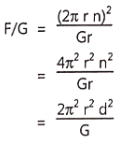
Where,
d is the diameter of rotation
G = 9.807 m/s²
Centrifugal effect = 2.013 n²d
When n is expressed in s’1 and d is in meters.
From the equation, it is clear that the centrifugal effect is directly proportional to the diameter and the square of the speed of rotation. So to increase the centrifugal effect, it is advantageous to use a centrifuge of the same size at a higher speed, rather than using a larger centrifuge at the same speed.
Principle Applications:
If the particles of suspensions are very small then a high centrifugal effect will be required to separate the particles. To separate such suspensions the size of the centrifuge is kept smaller but it is rotated at a very high speed (rpm). If a large amount of material is to be separated and a low centrifugal effect is sufficient to separate the suspension then the diameter of the centrifuge is increased and speed (n) is kept low.
Types Of Centrifugal Separations
There are two types of centrifugal techniques for the separation of particles; differential centrifugation and density gradient centrifugation. Density gradient centrifugation can further be divided into rate-zonal and isopycnic centrifugation.
Differential Centrifugation:
The simplest form of separation by centrifugation is differential centrifugation, sometimes called differential pelleting. Particles of different densities or sizes in a suspension will sediment at different rates, with the larger and denser particles sedimenting faster.
These sedimentation rates can be increased by using centrifugal force. A suspension of cells subjected to a series of increasing centrifugal force cycles will yield a series of pellets containing cells of decreasing sedimentation rate.
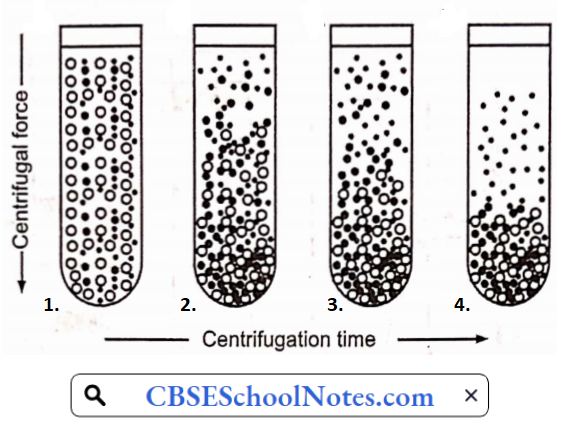
Particles of different densities or size will sediment.
At different rates with the largest and most dense particles sedimented the fastest followed by less dense and smaller particles.
- Differential pelleting is commonly used for harvesting cells or producing crude subcellular fractions from tissue homogenate.
- For example: Arat liver homogenate containing nuclei, mitochondria, lysosomes, and membrane vesicles that are centrifuged at low speed for a short time will pellet mainly the larger and more dense nuclei.
- Subsequent centrifugation at a higher centrifugal force will pellet particles of the next lower order of size
- For example: Mitochondria
- It is unusual to use more than four differential centrifugation cycles for a normal tissue homogenate. Due to the heterogeneity in biological particles, differential centrifugation suffers from contamination and poor recoveries.
Contamination by different particle types can be addressed by resuspension and repeating the centrifugation steps (i.e., washing the pellet).
Density Gradient Centrifugation:
Density gradient centrifugation is the preferred method to purify subcellular organelles and macromolecules. Density gradients can be generated by placing layer after layer of gradient media such as sucrose in a tube with the heaviest layer at the bottom and the lightest at the top in either a discontinuous mode.
The cell fraction to be separated is placed on top of the layer and centrifuged. Density gradient separation can be classified into two categories, rate- zonal (size) separation and isopycnic (density) separation.
1. Rate-Zonal Centrifugation:
In rate-zonal centrifugation, the problem of cross-contamination of particles of different sedimentation rates may be avoided by layering the sample as a narrow zone on top of the density gradient.
- In this way, the faster sedimenting particles are not contaminated by the slower particles as occurs in differential centrifugation.
- However, the narrow load zone limits the volume of the sample (typically 10%) that can be accommodated on the density gradient.
- The gradient stabilizes the bands and provides a medium of increasing density and viscosity.

The sample is layered as a narrow zone on the top of a density gradient (2). Under centrifugal force, particles move at different rates depending on their mass (3). The speed at which particles sediment depends primarily on their size and mass instead of density. As the particles in the band move down through the density medium, zones containing particles of similar size form as the faster sedimenting particles move ahead of the slower ones. Because the density of the particles is greater than the density of the gradient, all the particles will eventually form a pellet if centrifuged long enough.
2. Isopycnic Centrifugation:
In isopyclic separation, also called buoyant or equilibrium separation, particles are separated solely based on their density.
- Particle size only affects the rate at which particles move until their density is the same as the surrounding gradient medium.
- The density of the gradient medium must be greater than the density of the particles to be separated.
- By this method, the particles will never sediment to the bottom of the tube, no matter how long the centrifugation time is given.
- Starting with a uniform mixture of sample and density gradient under centrifugal force, particles move until their density is the same as the surrounding medium (2).

Upon centrifugation, particles of specific density sediment until they reach the point where their density is the same as the gradient media (i.e., the equilibrium position).
- The gradient is then said to be isopycnic and the particles are separated according to their buoyancy.
- Since the density of biological particles is sensitive to the osmotic pressure of the gradient, isopycnic separation may vary significantly depending on the gradient medium used.
- Although a continuous gradient may be more suited for analytical purposes, preparative techniques commonly use a discontinuous gradient in which the particles band at the interface between the density gradient layers.
- This makes harvesting certain biological particles (For example:, lymphocytes) easier.
Centrifuges
A centrifuge is a mechanical device that can subject an experimental sample to a sustained centrifugal force.
- Tubes containing experimental samples either in suspension or dissolved in a fluid can be “spun” at high speeds for particular lengths of time to achieve particular objectives.
- In bioresearch labs, these objectives include the separation, concentration, clarification, characterization, and purification of biological and biochemical materials.
- Two major components of a centrifuge are the drive mechanism and the rotor. The drive mechanism is the source of rotary motion and is powered by an electric motor, by air pressure, or by turbines, depending upon the type of centrifuge.
- The rotor is the large rotating element of a centrifuge into or onto which samples are loaded. It is driven about a fixed axis (or shaft) by the drive mechanism, with the expenditure of a large amount of energy.
- A loaded rotor must be well-balanced about its axis of rotation, to minimize vibration and strain on the shaft.
Centrifuge Types:
1. Speed:
The speed of a centrifuge is measured in revolutions per minute or rpm. Centrifuges are generally divided into 3 categories based on their maximum attainable speed:
- Low speed to a maximum of ~ 5 × 103 rpm.
- High speed to a maximum of ~2 × 104 rpm.
- Ultracentrifuges to maximum of ~105 rpm.
2. Temperature:
Centrifuges are either refrigerated or non-refrigerated. Refrigerated centrifuges have a built-in refrigeration unit surrounding the rotor, with a temperature sensor and thermostat permitting the selection of a particular temperature or a permissible temperature range that is maintained during centrifugation. Many biological samples are temperature sensitive, and centrifugation in the cold (say, 1-4°C) is frequently required
Centrifuges that are not refrigerated are normally used at whatever temperature the room they are in happens to be.
Types of Rotors:
There are two fundamental types of rotors:
1. Fixed-angle rotors, and
2. Swinging bucket rotors.
- Fixed-angle rotor: In fixed-angle rotors, the tubes containing samples are placed into shields or openings in the rotor at one particular pre-set angle. The tubes are thus tilted with their tops closer to the shaft than their bottoms, and remain in that fixed position during the run, regardless of rotor speed.
- Swinging-bucket rotor: In swinging bucket rotors, the tubes are initially vertical. The bottom of the sample tubes then swing outward freely as the shaft rotates, and the tubes are horizontal during the run. By the time the centrifuge stops, however, the tubes have returned to their starting vertical position. Swinging-bucket rotors are particularly useful for sedimenting a sample through a density gradient
A major advantage is that the density gradient solution (usually sucrose or cesium chloride) can be put into the centrifuge tubes vertically, while centrifugation takes place with the tubes in a horizontal position. Sedimented materials then appear as parallel bands running across the width of the tube, whereas, in a fixed-angle rotor, the bands would be diagonal. In the latter case there is a reorientation of contents upon removal of tubes from the rotor, whereas no reorientation of tube contents occurs with swinging bucket rotors.
Classification Of Industrial Centrifuges In Pharmaceutical Engineering
1. Perforated bowl or filter types
- Batch type
- Top-driven
- Under-driven
- Semicontinuous
- Continuous
2. Solid-bowl or sedimentation types
- Vertical
- Simple bowl
- Bowl with plates
- Horizontal
- Continuous decanters
Perforated Basket Centrifuge In Pharmaceutical Engineering
Depending on the arrangement of the perforated basket these instruments have two different names.
- If the basket is mounted above a driving shaft it is called a driven centrifuge.
- If the basket is suspended from a shaft it is called as top-driven centrifuge.
Perforated Basket Centrifuge Principle:
A perforated basket centrifuge is a filtration centrifuge. The separation is through a perforated wall based on the difference in the densities of solid and liquid phases. The basket has a perforated side wall. During centrifugation, the liquid phase passes through the perforated wall, while the solid phase is retained in the basket. The solid is removed after cutting the sediment by a blade after stopping the centrifuge.
1. Top driven centrifuge:
Top-driven centrifuge Construction:
It consists of a rotating basket suspended on a vertical shaft and driven by a motor from the top. The sides of the basket are perforated and are also. covered with a screen on the inside. Surrounding the basket is a stationary casing that collects the filtrate.
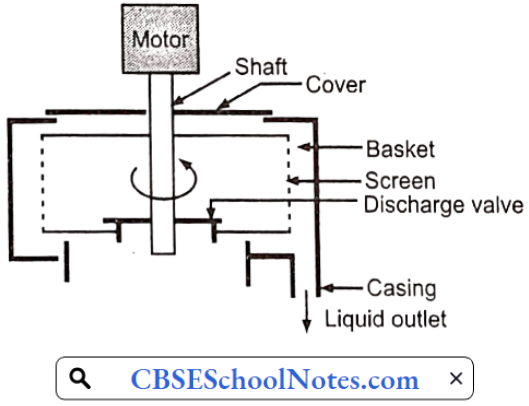
Top-driven centrifuge Working:
This machine is a batch-type machine. The material (suspension) is put into the basket. Then power is applied. The basket accelerates to its maximum speed. The particles and liquid are thrown by centrifugal force to the wall of the basket.
The liquid passes out through the screen and the solid particles are retained on the screen as deposit. After a definite time, the power is turned off, a brake applied, and the basket brought to rest. The discharge valve at the bottom of the basket is raised, and the deposited solid is cut from the side of the basket into the opening
2. Under driven centrifuge:
Under driven centrifuge Construction:
It consists of a rotating basket placed on a vertical shaft and driven by a motor from the bottom. The sides of the basket are perforated and are also covered with a screen on the inside. Surrounding the basket is a stationary casing that collects the filtrate.
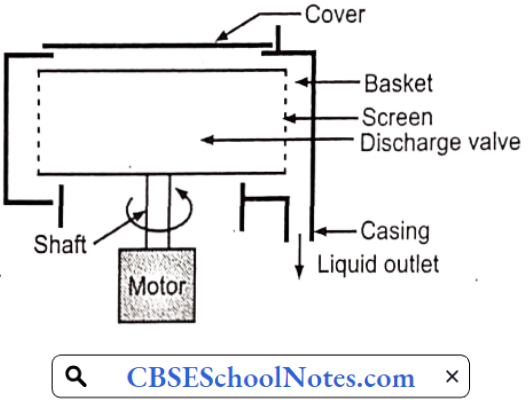
Under driven centrifuge Working:
This machine is a batch-type machine. The material (suspension) is put into the basket. Then power is applied. The basket accelerates to its maximum speed. The particles and liquid are thrown by centrifugal force to the wall of the basket. The liquid passes out through the screen and the solid particles are retained on the screen as deposit.
After a definite time, the power is turned off, a brake is applied, and the basket is brought to rest. The cover at the top of the basket is raised, and the deposited solid is cut from the side of the basket and collected.
Under driven centrifuge Use:
- Crystals can be separated from mother liquor. Liquids can be clarified by removing unwanted solids, and dirt from oils.
- In cloth industries after washing the liquid is strained and the cloths are taken out from the top cover.
Under driven centrifuge Advantages:
- The centrifuge is very compact and occupies very little floor place.
- It can handle slurries with a high proportion of solids and even those having paste-like consistency.
- The final product has a very low moisture content.
- In this method, the dissolved solids are separated from the cake.
- It is a fast process.
Under-driven centrifuge Disadvantages:
- The entire cycle is complicated resulting in considerable labour costs.
- It is a batch process.
- If the machine is adapted for prolonged operation, there is considerable wear and tear of the equipment.
- On prolonged operation, the solids may form hard cake, due to the centrifugal force, which is difficult to remove simultaneously
Semi-Continuous Centrifuge In Pharmaceutical Engineering
Semi-continuous centrifuge Principle:
A semi-continuous centrifuge is a filtration centrifuge. The separation is done based on the difference in the densities of the solid and liquid. This separation occurs through a perforated wall. The bowl contains a perforated side wall. During centrifugation, the liquid phase passes through the perforated wall, while the solid phase remains in the bowl. The solid is washed and removed by cutting the sediment using a blade.
Semi-continuous centrifuge Construction:
It consists of a rotating basket placed on a horizontal shaft and driven by a motor from side. The side of the basket is perforated. Surrounding the basket is a stationary casing that collects the filtrate, Slurry is introduced through a pipe that enters the basket through the center.
To wash the crystal the wash-pipe is also introduced through the center of the basket. The layer of cake is removed by a chute fitted with a knife. The knife, cuts down the cake within the basket. The knife-chute assembly is raised with the help of a hydraulic apparatus.

Semi-continuous centrifuge Working:
The basket is rotated horizontally by a motor. The slurry is introduced through the slurry entry pipe. The liquid passes out through the perforated side. The crystals remain within the basket. When the cake height is about 2 – 3 inches the slurry entry is stopped by a “feeler diaphragm valve assembly”.
The basket rotates at a predetermined time then the cake is washed with water. The basket is rotated for another predetermined time. After that the hydraulic apparatus raises the knife-chute assembly to cut the cake. The cake is collected through the chute.
Semi-continuous centrifuge Use:
- This is a semi-continuous type of centrifuge.
- Crystals can be separated from mother liquor.
- Liquids can be clarified by removing unwanted solids and dirt from oils.
Semi-continuous centrifuge Advantages:
Short-cycle automatic batch centrifuge is used when solids can be drained fast from the bowl.
Semi-continuous centrifuge Disadvantage:
- During discharge, considerable breakage of crystals is possible.
- Many moving parts are involved making the construction and functioning more complicated.
Non-Perforated Basket Centrifuge In Pharmaceutical Engineering
Non-perforated Basket Centrifuge Principle:
This is a sedimentation centrifuge. The separation is based on the difference in the densities of solid and liquid phases without a porous barrier. The basket contains a non-perforated side wall during centrifugation, solid phase is retained on the sides of the basket; while the liquid remains at the top, which is removed by a skimming tube.
Non-perforated Basket Centrifuge Construction:
It consists of a metallic basket. The basket is suspended on a vertical shaft and is driven by a motor using a suitable power system.

Non-perforated Basket Centrifuge Working:
The suspension is fed continuously into the basket. During centrifugation, the solid phase is retained on the sides of the basket, while the liquid remains on the top. The liquid is removed over a weir or through a skimming tube.
When a suitable depth of solids has been deposited on the walls of the basket, the operation is stopped. The solids are then scraped off by hand or using a scraper blade
Non-perforated Basket Centrifuge Use:
Non-perforated basket centrifuge is useful when the deposited solids offer high resistance to the flow of liquid.
Super Centrifuge In Pharmaceutical Engineering
Super Centrifuge Principle:
It is a solid bowl-type continuous centrifuge used for separating two immiscible liquid phases. It is a sedimentation-type centrifuge. During centrifugation, the heavier liquid is thrown against the wall of the bowl while the lighter liquid remains as an inner layer. The two layers are simultaneously separated
Super Centrifuge Construction:
It consists of a long, hollow, cylindrical bowl of small diameter. The bowl is suspended from a flexible spindle at the top and the bottom is fitted loosely in a bush. It is rotated on its vertical axis.
Feed is introduced through the bottom through a nozzle. Two liquid outlets are provided at different heights. Inside the bowl, there are three baffles to catch the liquid and force it to travel at the same speed of rotation as the bowl wall.
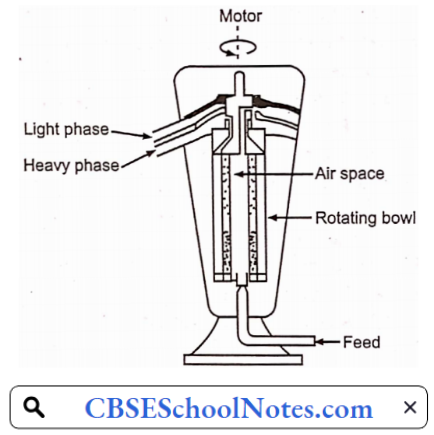
Super Centrifuge Working:
The centrifuge is allowed to rotate on its vertical axis at about 2000 rpm. The feed is introduced at the bottom through a nozzle under pressure. During centrifugation, two liquid phases separate based on their densities.
The heavier liquid moves towards the periphery and the lighter liquid forms an inner layer. Both liquids climb to the top of the vertical bowl. These two layers are simultaneously separately removed from different heights through modified outlets.
Super Centrifuge Use:
Super centrifuge is used for separating liquid phases of emulsions in foods and pharmaceuticals.
Centrifugation In Pharmaceutical Engineering Multiple Choice Questions
Question 1. Which property of substance influences centrifugation?
- Surface area
- Density
- Interfacial tension
- Melting point
Answer: 2. Density
Question 2. Centrifugation is used for
- Mixing
- Purification
- Separation
- Sizing
Answer: 3. Separation
Question 3. The solid that has high specific gravity will remain in which location after centrifugation?
- Bottom
- Top
- Middle
- Side of these
Answer: 1. Bottom
Question 4. For sedimentation type, the centrifuge has one of the following conditions
- Basket is non-perforated
- Basket is perforated
- Containing filter aid
- Containing filter medium
Answer: 1. Basket is non-perforated
Question 5. Centrifuges are used for the analysis of dosage forms to analyze:
- Physical stability
- Chemical stability
- Photostability
- Thermal stability
Answer: 1. Physical stability
Question 6. What are the two general types of centrifuge devices for solid-liquid separations?
- Sedimentation centrifuges, filtering centrifuges
- Sedimentation centrifuges, decantation centrifuges
- Filtering centrifuges, sintering centrifuges
- Sedimentation centrifuges, two-way centrifuges
Answer: 1. Sedimentation centrifuges, filtering centrifuges
Question 7. After centrifugation when the sublimate settles, clear liquid
- Can be allowed to rest
- Can be allowed to form crystals
- Can be decanted off
- Can be evaporated
Answer: 3. Can be decanted off
Question 8. The unit for measurement of the velocity of the centrifuge is
- Diameter of rotation
- Meter/sec²
- Meter square per second
- Revolutions per minute
Answer: 4. Revolutions per minute
Question 9. Which factor from the following does not affect the centrifugation?
- Centrifugation time
- Viscosity of slurry
- Speed of centrifuge
- Temperature
Answer: 4. Temperature
Question 10. During discharge breaking of crystals is possible in
- Horizontal continuous centrifuge
- Non – Perforated basket centrifuge
- Semi-continuous centrifuge
- Super centrifuge
Answer: 3. Semi-continuous centrifuge
